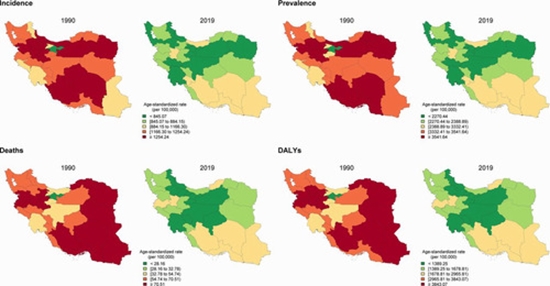Burden of road traffic injuries in Iran: A national and subnational perspective, 1990-2019
Reliable and valid information on burden of road traffic injuries (RTIs) is essential for short-term and long-term planning. We designed the present study to describe the levels and trends of burden of RTIs in Iran from 1990 to 2019.

This is an observational epidemiological study. We used the Global Burden of Disease (GBD) 2019 estimates to report RTIs incidence, prevalence, mortality and disability-adjusted life-years (DALYs) by sex, age group and road user category in Iran and each of the 31 provinces from 1990 to 2019.
Results Age-standardised incidence, prevalence, death and DALY rates of RTIs decreased by 31.7% (95% uncertainty interval (UI): 29.4 to 33.9), 34.9% (33.8 to 36.0), 57.7% (48.1 to 62.3) and 60.1% (51.7 to 65.2), respectively between 1990 and 2019. The 2019 age-standardised DALY rates varied from smallest value in Tehran 303.8 (216.9 to 667.2) per 100 000 to largest value in Sistan-Baluchistan 2286.8 (1978.1 to 2627.9) per 100 000. The burden of RTIs was mainly related to injuries sustained by drivers or passengers of motorised vehicles with three or more wheels and pedestrians’ injuries, mostly affected males aged 15–29 years and individuals aged ≥70 years.
Conclusion The reducing trend in the burden of RTIs in Iran possibly reflects the effectiveness of the intervention programmes. However, with regard to the Sustainable Development Goals the burden is still at an alarming level. Further reductions are necessary for specific road user groups such as adolescent and adult male drivers or passengers of motorised vehicles, also pedestrians aged ≥70 years.





ارسال نظر